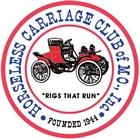In 1944, the year the Horseless Carriage Club of Missouri was founded, the clouds of war still hung over Europe and Japan. Many of the pre-early 1940s cars went the way of the scrap heap and then the smelter. It was a sad ending for many prestigious and fine motorcars. Still, some folks had put cars away in barns and long-forgotten garages. However, there were few “car collectors” and aficionados at the time. Cars were considered transportation and purely utilitarian. Besides, with a war on, there was little focus on preserving what we now would consider antique and classic vehicles. Surprisingly though, in St. Louis, there were a group of individuals that began to meet to discuss cars and reminisce about the good old days — the days of four wheels and no brakes!

Many of these individuals had ties to the automotive world since St. Louis was, for a time, the automotive capital of the United States. For years we were then second only to Detroit. The early founders of HCCM amounted to five men and that list included George P. Dorris, Alex Deeken, Harry Rook, Wayne Bledsoe, and Frank Steward. All were automotive pioneers. We trace our beginnings back to December 5th, 1944. That’s when the small group of folks who used to gather informally to discuss cars and periodically do “Brass Era” tours decided to become an organized body. The HCCM is the oldest regional club of its type in America. We are also the oldest region affiliated with the Horseless Carriage Club of America. By 1962 there were 75 “member families” in the HCCM. That was a lot back then and the club dominated the regional vintage car scene. 1962 was the year that the Easter Concours d’Elegance was born. This is what gave the Horseless Carriage Club of Missouri a public face.
Ever since, no other antique car show in the Greater St. Louis area has held such appeal to the public for so many decades. It is a legendary tradition. What caused the change and why did “old” cars suddenly have an appeal. People have fond memories of the past — the legends of the silver screen immortalized the automobile with greats such as Harlow, West, Gable, Garland and others. History has a way of guilding even the worst of times.
The dust bowl depression years of the 30s bring forth memories especially in novels like John Steinbeck’s, The Grapes of Wrath, of the exodus west on Route 66. The essence of the freewheeling and roaring 20s was captured by F. Scott Fitzgerald in The Great Gatsby. There’s a certain nostalgic appeal to each era. The 50s spawned movie legends such as James Dean and Marilyn Monroe. We saw cars like the 1957 Chevy, the 1959 “Tail-fin” Cadillac, the Corvette and the 1957 T’Bird emerge.
The 60s “age of uncertainty” brought us Mustangs, Firebirds and “flower power” VWs and even ” Ralph Nader” Corvairs. In the 70s we saw Detroit quality slip way down with the Mustang II, Pintos, Vegas and other rather non-descript ” cookie- cutter” cars yet there were still some notables such as the Cadillac Eldorados and a few muscle cars. The Horseless Carriage Club lives on. We don’t see as many “Brass Era” cars as we would like, but the old timers who seem to own the majority of these cars are well getting really old are have passed away. Going back to our first Easter Concours in 1962 we saw a number of “Acetylene Era (Pre-1913) cars. There was Don Carretti with his 1911 Buick touring, N. W. McClure with a 1912 Ford and Ross Steiner with an 1897 Holdermann. In Vintage Class (1913-1919), there was Wally Nutter in his freshly restored 1913 Maxwell, Bill Robards in his 1918 Hupmobile and many others. Now we see a lot of cars from the 60s and 70s. Even the 50s cars are getting somewhat scarce.
